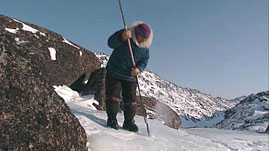Teachers' Domain - Digital Media for the Classroom and Professional Development
User: Preview

Source: National Film Board of Canada
In this video segment adapted from the National Film board of Canada, learn about Inuit culture. Interviews with indigenous peoples and archival footage document concerns about how their traditional ways of life have changed from living off the land to being more dependent on the larger world; the importance of a traditional education that teaches technical skill and character; the connection between the local environment and global climate changes; and how adaptability has its limits.
Through the subsistence practices of hunting, fishing, and gathering, Native peoples of Alaska, Canada, and other Arctic regions maintain an intimate relationship with nature. They harvest natural resources from the land and sea using traditional methods and knowledge, which provide them with detailed understanding of the land, weather, and animal patterns of their local area. Indigenous cultures have survived for thousands of years by living close to the land and by being flexible; the adaptability of the cultures has allowed them to adjust to various changes and shifts in climate and weather, as well as in fish, wildlife, and plant availability.
Currently, the quality of traditional food sources is being threatened. Agricultural and industrial activities produce a variety of contaminants that make their way into ecosystems and food sources. Most of the contaminants found in the Arctic are produced at low- or mid-latitudes, but they are transported northward by wind and water. In particular, heavy metals and persistent organic pollutants (POPs), which break down slowly in the environment and are capable of traveling long distances, can remain in ecosystems for long periods of time, and can accumulate to dangerous levels in the food chain.
Transport of POPs through the atmosphere is relatively fast; pollution from Europe can reach the Arctic in just a few days. Contaminants that are volatile (those that evaporate easily) or semivolatile can be picked up as gases by the wind and transported northward until cooler temperatures deposit them onto Earth's surface (often by first condensing them onto particles in the atmosphere that then fall as rain or snow). Some contaminants are transferred through several cycles of volatilization and deposition, taking a series of hops between Earth's surface and atmosphere—this is known as the grasshopper effect. Pollutants also reach the Arctic via ocean currents. This pathway can take several years, which means that there is a significant lag between when the pollutants were produced and when they appear in the environment. As a result, even though many contaminants have been banned or restricted, their effects may still be felt for years to come.
Rivers that flow through industrial areas and drain into the Arctic Ocean also transport pollutants. Snow and ice store pollutants, which are released as they melt. Pollutants in the environment enter into ecosystems when organisms absorb them from the air and water or consume them. Once the pollutants become a part of the food chain, they can reach toxic levels through the process of biomagnification, in which contaminant levels become more concentrated at higher levels of the food chain. The presence of contaminants in the environment directly affects the traditional diet (which includes local vegetation, seabirds, caribou, fish, seal, walrus, whale, and polar bear) and is cause for concern for people who eat these foods, as toxins can affect reproductive, neurologic, and immunologic health.
 Loading Standards
Loading Standards Teachers' Domain is proud to be a Pathways portal to the National Science Digital Library.
Teachers' Domain is proud to be a Pathways portal to the National Science Digital Library.
